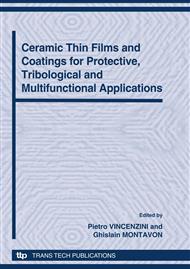[1]
A, D, Nashif, D. I. G. Jones, and J. P. Henderson, Vibration Damping, (John Wiley, USA 1985).
Google Scholar
[2]
P. J. Torvik, R. Willson and J. Hansel, in Proc. Material Science and Technology Conference and Exhibit, MS&T 07, (Curran Associates Inc, USA 2009), p.139.
Google Scholar
[3]
P. J. Torvik, Int. J. Solids and Structures, Vol. 46, No. 5 (2009), p.1066.
Google Scholar
[4]
S. N. Patsias, N. Tassini and R. Stanway, in Smart Structures and Materials 2004: Damping and Isolation, ed. by K-W. Wang, Proc. of SPIE, 5386 (2004), p.174.
DOI: 10.1117/12.538743
Google Scholar
[5]
N. Tassini, et. al, J. European Ceramic Soc., Vol. 27, Issues 2-3 (2007), p.1487.
Google Scholar
[6]
P. J. Torvik and J. Hansel, J. Mat. Science and Eng. Vol. 131, No. 3, (2009), pp.031003-1.
Google Scholar
[7]
S. Reed, Development of Experimental, Analytical, and Computational Techniques Appropriate for Nonlinear Damping Coatings, (Dissertation, Air Force Institute of Technology, USA 2007).
Google Scholar
[8]
K. R. Cross, W. R. Lull, R. L. Newman and J. R. Cavanagh, Journal of Aircraft, Vol. 10, No. 11, (1973), p.689.
Google Scholar
[9]
M. Shipton and S. Patsias, in Proc. 8th Nat. Turbine Engine HCF Conf. (2007), pp. 5e1-27.
Google Scholar
[10]
P. J. Torvik, Journal of Applied Mechanics, Vol. 76, No. 6 (2009), pp.061018-1.
Google Scholar
[11]
P. J. Torvik in Integration of Machinery Failure Prevention Technologies into System Health Management, (Society for Machine Failure Prevention Technology, Dayton, OH, USA 2007).
Google Scholar
[12]
B. Movchan and A. Ustinov, in Proc. Sym. on Evaluation, Control, and Prevention of HCF in Gas Turbine Engines for Land, Sea, and Air Vehicles (NATO RTO-MP-AVT-121, Spain 2005).
Google Scholar
[13]
A. I. Ustinov, B. A. Movchan, F. Lemke, and V. S. Skorodzievskii, Vibration in Technique and Technology, No. 4, (2001), p.123.
Google Scholar
[14]
J. Vanderstraeten, U. S. Patent 5, 033, 579 (1991).
Google Scholar
[15]
S. Patsias, Key Engineering Materials, Vol. 319 (2006), p.181.
Google Scholar
[17]
S. Filippi and P. J. Torvik, Proc., ASME Turbo Expo, Paper GT2010-22090 (2010), to appear. 2l 1 1 1 2 2 f.
Google Scholar
[16]
P. Torvik, R. Willson, J. Hansel, and J. Henderson, J., in Proc. Material Science and Technology Conference and Exhibit, MS&T 07, (Curran Associates Inc, USA 2009), p.151.
Google Scholar
[18]
J. P. Henderson, A. D. Nashif, J. E. Hansel, and R. M. Willson, in Ceramic Engineering and Science Proc., Ed. D. Singh and D. Salem, Vol. 30. No. 3, (John Wiley, USA 2009), p.9.
Google Scholar
[19]
ASTM E 756-05 (ASTM International, USA 2005).
Google Scholar


